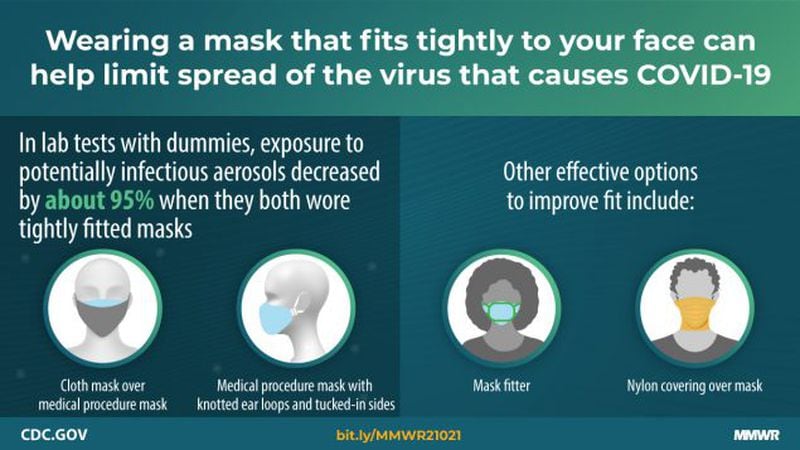Almost since the beginning of the pandemic, experts have told the public about the importance of three things: washing your hands, maintaining a social or physical distance of at least six feet and wearing a mask.
Now, a new Centers for Disease Control and Prevention study has given more credit to the notion that double-masking is an effective method of limiting the spread of the coronavirus. This comes as COVID-19 cases and deaths surge in Georgia and around the nation.
The CDC conducted a study in January that tested two methods of improving the fit and filtration of surgical masks. One involved double masking.
After experimenting with varying techniques for mask effectiveness, the agency concluded that wearing a cloth mask over a surgical mask — along with using a mask filter or wearing a nylon covering over a mask — are effective options to improve mask’s fit and decrease exposure to aerosols that could cause infection.
Credit: Centers for Disease Control and Prevention
Credit: Centers for Disease Control and Prevention
“It has been backed up by research that two masks are, in fact, better than one,” CBS Denver’s medical director Dr. Dave Hnida told CBSN Denver in January. “Specifically what we’re saying is that two masks may actually equal the protection you would get from N-95 masks, which is considered the best mask there is short of a complete respirator-type unit.”
He added that using two masks creates “an obstacle course for the viral particle to make its way from the air into your nose and throat and then into your lungs.”
That notion has been backed up by other experts including one in virus transmission at Virginia Tech, Linsey Marr.
She told the New York Times that “if you combine multiple layers, you start achieving pretty high efficiencies” of preventing the virus from coming through and leaving the airways.
Research published in the journal Med, which Marr was part of, noted people can either wear a cloth mask snuggly over the top of a surgical mask, with the latter acting as a filter and the former providing another layer of filtration, or wear a three-layer mask with outer layers made of a flexible, tightly woven fabric that can fit the face well. The middle layer on this mask would be a non-woven, high-efficiency filter material akin to that of a vacuum bag.
But a three-layer mask — which the World Health Organization has said should be the make-up of fabric masks — is different from wearing three different masks in an effort to triple mask and increase protection against the coronavirus.
Doing that could cause more harm than good.
According to NPR, it will make it harder to breathe — and that’s possible with two masks. That’s when a single, multilayered mask would come into play, Dr. Abraar Karan, a physician at Brigham and Women’s Hospital in Boston, told the news outlet. Karan also recommended that the mask is comfortably fitted over your nose and mouth.
About the Author







